Friday, October 18th, 2013
 By Carolyn Yeager
By Carolyn Yeager
In January 2011, I featured a Letter of the Week from Hailey S. In November the same year I featured two more, from Shelby and Sarah. Now I have received three more complaints about this site from (another?) Hailey, a Katie and a Lauren — right in a row. Thank you ladies!
But it’s an odd thing — the latest three were all sent from the same computer. And with an email address that ends in the same edu., which I won’t reveal. I’m not even sure it’s legitimate … that is, a real school. Could these young ladies be friends conspiring together in writing their comments? Could they even be the same person using different names and slightly different email addresses?
The content and point of view is similar, but written in different ways. You will find that “belief” and “believing” are the major basis for, well, believing the “holocaust.” These comments are also similar to the earlier ones I published from Hailey S, Shelby and Sarah, although better written and thought-out. So I could reply to them all together, but since they are written to three different blog articles they appear on different pages. This is why I decided to reply to them here, under the title of “More Letters of the Week.”
First, from Hailey, who sent her comment to “Elie’s Adventures in Buchenland” on Oct. 14:
I find the trivialization of the Holocaust extremely disgusting. It maybe that some don’t believe that Elie Wiesel was an actual part of the Holocaust, but that does not mean anyone has the right to make fun of or make light of a horrific historical event. An event that almost entirely wiped out an entire group of people. There is an amount of dignity that must be maintained when dealing with this horrific time in history.
I already replied to Hailey on that page, so I’ll just say here that she’s free to express her feelings but I hope she understands that that is all she’s doing. Hailey has been indoctrinated into believing that “Holocaust survivors” are telling the truth about their “horrific” suffering and that “an entire group of people [by which she means Jewish people] were almost entirely wiped out.” Honest research has shown otherwise, but Hailey prefers to ignore this research.
The second comment is from Katie, who sent her comment to “Elie Wiesel Was Not in Buchenwald Made Simple“ on Oct. 16:
I think that there could be a logical explanation to explain the holes in Elie’s story. I cannot bring myself to believe that someone would fictionalize a story on the holocaust and its terrible events. When someone under goes a traumatic event they will most likely not be able to remember every detail perfectly therefore he may have been confused on the dates and times. Elie has also grown older in age which also may make it difficult for him to remember. His book Night, is very detailed and descriptive which makes it difficult to believe that he could make those events up. This blog also states that Elie has not been asked to explain his discrepancies in his “tale”. Could it possibly be because there is no solid proof to question his story? And if he wasn’t actually a survivor than his book is still an incredible account of a Jewish person in the Holocaust and is still educational and provides people with an insight to the terrible things that happened.
Poor logic here. Katie says, “I cannot bring myself to believe …” — she is also putting her belief first. How many times can we repeat that reality is not about belief. It’s about facts and evidence. Belief belongs in religion — in this case the religion they have all been brought up in: Holocaustism.
Katie brings up belief a second time, saying in essence that after reading Night, she finds it “difficult to believe that he could make those events up.” But Wiesel is primarily a fiction writer and has made up lots of stories about Jews; in fact Night was for a long time listed and sold as fiction! Good fiction makes us believe it’s real even when we know better.
As to the “logical explanation” Katie thinks could be found, she doesn’t come up with one. Illogically, she says that Elie was traumatized and thus not able to remember well. But Elie has always said he waited for 10 years to write his book so that he would have a clearer mind about it. Her other “logical explanation” is: Elie is now elderly and has a poor memory, thus he gets mixed up on dates and times. But Elie wrote Night in 1955, and it is in this book that the problems exist — the book itself is inaccurate and inconsistent. Since that time he has continued to say different things — inconsistent things.
Katie’s final remark falls back on what the bulk of “Holocaust” defenders come up with: Even if he wasn’t a survivor, it’s still an “incredible [fictional] account” providing an insight into the terrible things that happened. How does he know what happened if he wasn’t there? He made it all up, taking the framework for what others had already said about it. Stop defending this multi-millionaire shyster, Katie.
Third, is Lauren, who sent her comment to “Ken Waltzer inadvertently supplies proof that Elie Wiesel was not at Buchenwald“ on Oct. 16:
I find this constant speculation about the validity of the Holocaust and its survivors extremely disturbing. The Holocaust was not a glamorous event, therefore, I find it hard to believe that someone would make up a story about being a victim of such tragedy. While I realize that many people would consider my opinion to be a ‘too optimistic’ view of human nature and morality, there is a lot of information to support the fact that Elie Wiesel was at the camp without the information that Mr. Waltzer is supposedly with-holding.
Once more, we find the belief mode: “I find it hard to believe that someone would make up a story…” Why? Hundreds of fake survivors have done so. What does it take for you to give up this childish belief in a religion of sadistically persecuted Jews?
You say it is not a glamorous event … but for ordinary “non-glamorous” Jews it is the ultimate stardom, and a very lucrative source of money too. Not only from the books they write, but also from the talks they give on the “speakers circuit” — and how they love all that respectful attention. They also love fooling so many Gentiles.
You say “there is a lot of information to support the fact that Elie Wiesel was at the camp …” No, there isn’t! This entire web site is devoted to showing that the alleged “information” is false or simply does not exist. Yet you cling to your belief in the non-existent. That is religion, not history, Lauren.
You are also mis-stating the case when you say Mr. Waltzer is withholding information. He is withholding nothing, for he doesn’t have the information he claims. Your Mr. Waltzer is another fraud who’s been caught in his frivolous promises. I know it’s tough for you to accept. But logic should tell you that if Waltzer had the information he would have put it out there already. He is embarrassing himself as a university professor by remaining silent and not publishing it. In failing to do so, he is proving my point … not yours.
Well, young ladies, thanks for your written words. They are a treasure. You are of course welcome to write again, but I caution you that I expect you to address my replies to you in some way. If you just write more of the same I probably won’t publish it. I don’t want to bore the readers. So step up to the plate!
18 Comments
Category Featured | Tags: Tags: belief vs evidence, Buchenwald, Elie Wiesel, history vs religion, Holocaustism, Kenneth Waltzer, Letter of the Week,
Social Networks: Facebook, Twitter, Google Bookmarks, del.icio.us, StumbleUpon, Digg, Reddit, Posterous.
Tuesday, June 11th, 2013
[Continuation from “Is it time to call Ken Waltzer a fraud?“]
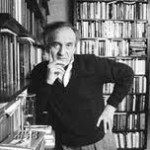 by Carolyn Yeager
by Carolyn Yeager
copyright 2013 carolyn yeager [last updated 12-5-2015]
“In literature, Rebbe, certain things are true though they didn’t happen, while others are not, even if they did.” –Elie Wiesel speaking of his book Night, from his Memoir: All Rivers Run to the Sea
For the skeptics and know-nothings who have written in suggesting Eli Wiesel was not in the camps, that Night is purely fiction, you are all dead wrong. The Red Cross International Tracing Service Archives documents for Lazar Wiesel and his father prove beyond any doubt that Lazar and his father arrived from Buna to Buchenwald January 26, 1945, that his father soon died a few days later. –Kenneth Waltzer in a comment at Scrapbookpages Blog, March 6, 2010.
The story that Michigan State University history professor Kenneth Waltzer has told us about Elie Wiesel in Buchenwald, based on Wiesel’s book Night, is not true.1
Elie Wiesel was not incarcerated at Buchenwald.
He was not liberated from Buchenwald.
He was not a victim of the “Nazis” there.
How do we know that?
Well, how do we know that Elie Wiesel was at Buchenwald?
1. We have a numerical file (registration) card for Lazar Wiesel from Sighet, born 1913.
2. We have a questionaire (Fragebogen) made out for and signed by a Lázár Wiesel, a 16-year old Jew from Sighet.
3. We have a transport list from Buchenwald to France with the name Lazar Wiesel, born Oct. 4, 1928.
4. We see a picture of him in the famous photograph taken in Barracks #56 on April 16, 1945.
5. We have a death report for Abraham Viezel (not Schlomo or Solomon) on 2-2-1945, in Block 57.
6. We have a transport list from Auschwitz to Buchenwald with the names Lazar Wiesel, #123565, born 4 September 1913 and Abram Viezel, #123488, born 10 October 1900.
7. We have a photo of the “rescued children” marching out of the Buchenwald main gate on April 27, 1945.
8. We have the book Night, in which he says he was.
* * *
The above list is ordered according to its perceived importance in proving Wiesel was at Buchenwald, so I’ll start from the bottom (least important) in showing that they don’t prove any such thing.
8. The persuasiveness of the book Night has been dealt with in several other places, for example here and here, and is not considered evidence.
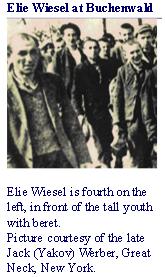 7. Photo of Buchenwald Boys (scroll down a bit). The boy that Ken Waltzer has identified as Elie Wiesel (who was identified to him as such by Jack Werber of Great Neck, NY, a “holocaust survivor” activist) is clearly not Wiesel and has not been identified as Wiesel by anyone other than Ken Waltzer. Waltzer had this image/blurb, at right, on his MSU website for years [the site was removed sometime in 2012], making him look foolish. Will Waltzer admit that he was wrong all this time, or try to sweep it under the proverbial rug?
7. Photo of Buchenwald Boys (scroll down a bit). The boy that Ken Waltzer has identified as Elie Wiesel (who was identified to him as such by Jack Werber of Great Neck, NY, a “holocaust survivor” activist) is clearly not Wiesel and has not been identified as Wiesel by anyone other than Ken Waltzer. Waltzer had this image/blurb, at right, on his MSU website for years [the site was removed sometime in 2012], making him look foolish. Will Waltzer admit that he was wrong all this time, or try to sweep it under the proverbial rug?
6. The Transport List to Buchenwald only proves that Lazar Wiesel, age 31 (a locksmith by trade) and Abram Viesel, age 44, arrived at Buchenwald on January 26, 1945 from Auschwitz. See here and here. Elie’s father’s name was Solomon (Schlomo); he never went by Abram, nor did Elie ever go by “Lazar.” Lazar had been given the Buchenwald number 123565, while Abram had 123488. There is no honest way to turn these two into Eliezer Wiesel and his father. Both the birth dates and the names are wrong. It only proves that Elie Wiesel claimed for himself the Auschwitz prisoner number (A7713) of another man. Where is the tattoo on Elie’s arm that reads A7713?
5. The Death Report for Abraham Viezel, Buchenwald prisoner number 123488, same as on the transport list. His death is recorded as taking place in Block 57 on February 2, 1945, not Jan. 29, 1945 as is clearly stated in Night for Eliezer’s father.2
4. The Famous Liberation Photo taken at Buchenwald on April 16, 1945 is said to show Elie Wiesel among the men in the bunks. Beside the fact that the face pointed out as Elie’s doesn’t look like him (for reasons which have been made clear here and here) and that he did not identify himself in it until 1983 when the campaign to get him a Nobel Prize began, there is also his hospitalization which began on April 14th.3 He could not have been near death in a hospital and in the picture at the same time! Ken Waltzer took the liberty of changing the date the photo was taken to April 12 or 13th to get around that inconvenient fact.4
3. The Transport List to France. When did Elie Wiesel’s birthday change to Oct. 4th from Sept. 30th? A majority of boys on this list share the birth year of 1928. The person listed as Lazar Wiesel is the same Lazar Wiesel that the Questionaire refers to, but we have determined that this person could not have been Elie Wiesel. It is true that Elie Wiesel went to France, but how he got there, and when, is not clear.
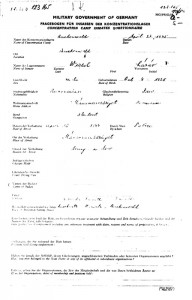 2. The Questionaire [scroll down page] was apparently prepared for and signed by every prisoner prior to their release. It is dated April 22, 1945; the prisoner number is 123165, different by one digit from our previous Lazar Wiesel #123565, and is the number belonging to a recently deceased inmate, Pavel Kun,5 whose death is recorded as March 8, 1945. Since Elie Wiesel allegedly received his number upon arrival on Jan. 26, 1945, he would not later be given a new number from a prisoner who just died. It would seem from this that Lázár Wiesel is a newcomer-of-sorts who had been given a number that had just been released.
2. The Questionaire [scroll down page] was apparently prepared for and signed by every prisoner prior to their release. It is dated April 22, 1945; the prisoner number is 123165, different by one digit from our previous Lazar Wiesel #123565, and is the number belonging to a recently deceased inmate, Pavel Kun,5 whose death is recorded as March 8, 1945. Since Elie Wiesel allegedly received his number upon arrival on Jan. 26, 1945, he would not later be given a new number from a prisoner who just died. It would seem from this that Lázár Wiesel is a newcomer-of-sorts who had been given a number that had just been released.
The name Lázár is spelled with distinct, heavy accent marks; the birth date given is Oct. 4, 1928 (Elie’s is Sept. 30); date of arrest is April 16, 1944 (Elie’s family’s deportation was at the end of May/early June – see here); the signature on the back does not match Elie Wiesel’s known signature or handwriting. The signature is also written with accents over the a’s in Lázár, implying that the accenting originated with Lázár and not with the official who filled out the form.6
But, beyond all this, on April 22 Elie Wiesel, by his own account, was in a hospital in or near Buchenwald camp “hanging between life and death” after coming down with severe food poisoning. He was taken to the hospital on April 14 and not released until April 28, according to his own words in his “autobiographical” Night and his 1995 memoir All Rivers Run to the Sea. Therefore, he could not have been interviewed or signed the questionaire on April 22nd. (See Endnote 3)
1. The Numerical File Card (below), made out at registration, is for Lazar Wiesel from Maromarossziget, born Sept. 4, 1913, making him at the time 31 years old. His Buchenwald prisoner number 123565 is written on the upper right. The card indicates his father, Szalamo Wiesel, was also at Buchenwald, while his mother, Serena Wiesel, nee Feig was currently interned at KL Auschwitz (at the time of Jan. 26, 1945).
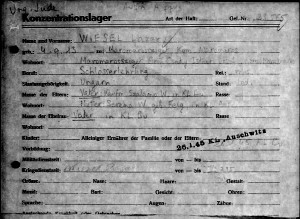 This registration card is the only item that casts some doubt7 over Nikolaus Grüner’s account of Lazar and Abram. But it does not prove that this Lazar Wiesel is Elie Wiesel. It does not make any sense that all the birth dates for the same person would be different! It makes more sense that there were several persons with similar names.
This registration card is the only item that casts some doubt7 over Nikolaus Grüner’s account of Lazar and Abram. But it does not prove that this Lazar Wiesel is Elie Wiesel. It does not make any sense that all the birth dates for the same person would be different! It makes more sense that there were several persons with similar names.
Note that this card identifies Lazar Wiesel as a locksmith (Schlosserfehrling), a trade of which the 15-year-old Elie Wiesel never would have identified himself. In Night he identified himself upon entry to Auschwitz as “a farmer” (p. 32, MW translation) and continued not to boast of any skill (of which he had none anyway) so as not to be sent out for work.
* * *
So we end up realizing there is no evidence that Elie Wiesel ever set foot in Buchenwald in 1945. What’s more, he and others (including Ken Waltzer) have actively and knowingly lied about photographs, dates, times, names, etc. This has gone on with the blessing and support of Yad Vashem Holocaust Memorial in Israel, the US Holocaust Memorial Museum in Washington DC, the New York Times Company, Associated Press, and other establishment media – and the multitude of Jewish/Holocaust-promoting organizations across the globe. Think of Elie Wiesel conducting US President Obama and German Chancellor Merkel around the Buchenwald Memorial in 2009! It is a giant criminal conspiracy when one really takes a look at it. The ramifications are immense.
Someone, preferably Elie Wiesel, needs to explain all the discrepancies in his tale. He has never offered to and never been asked to. If Wiesel won’t attempt an explanation, then Ken Waltzer the Historian with the PhD from Harvard University must do so. In his scholarly studies, Waltzer includes Elie Wiesel as one of the “Rescued Children of Buchenwald. ” One duty of a scholar is to answer serious and justified questions about their work. Elie Wiesel Cons The World is asking such questions and so we await an answer.
Update 6-15 Great idea from a reader: Write to Prof. Ken Waltzer at [email protected] and ask him politely to answer the questions raised in this article.
Endnotes:
1. Prof. Kenneth Waltzer has removed this article from the Internet, along with his entire website which the article had been a part of for several years, and says he has written a new separate article on Elie Wiesel in Buchenwald.
The book is on track, and I have also completed a separate essay to be published on Elie Wiesel and Buchenwald. -Ken Waltzer to me, Carolyn Yeager, in an email, March 2013
He obviously doesn’t want comparisons made between his old and new article and is waiting as long as possible to make it public. Or is he still reworking it?
2. “Then I had to go to sleep. I climbed into my bunk, above my father, who was still alive. The date was January 28, 1945. I woke up at dawn on January 29. On my father’s cot there lay another sick person. They must have taken him away before daybreak and taken him to the crematorium.” –Night, 2006 Marion Wiesel translation, p. 112
The Yiddish original, Un di Velt Hot Gesvign, says Father’s death occurs on the 18-19 of Shevat:
For a couple of hours I stayed by him and looked at his face long and well […] Then they forced me to go lie down to sleep. I climbed up to the uppermost bunk and I did not know that in the morning, on awakening, I would find my father no more.
It was the eighteenth of Shevat, 5705.
Nineteenth of Shevat. Early in the morning.
I got up and ran to my father. Another sick man was lying in his place.
I had a father no more. (p 238)
Readers might be surprised to learn that the Hebrew calendar date of 18-19 Shevat, 5705 corresponds to February 1-2, 1945. This gives credence to the idea that Abram Viezel’s death is the model for the story And The World Remained Silent. The date in the original story for Father’s death and the date of Buchenwald records for Abram’s death concur. This leads me to question Elie Wiesel’s personal knowledge of events at Buchenwald because why would he change the date to Jan. 28-29 if he knew the significance of Feb. 1-2?
Also, the death took place in Block 57, the report said, which would seem to be next door to Block 56 where the famous Buchenwald liberation photo is said to have been taken.
3. “Three days after the liberation of Buchenwald, I became very ill: some form of food poisoning. I was transferred to a hospital and spent two weeks between life and death.” –Night, 2006 Marion Wiesel translation, p. 118
Also in Un di Velt Hot Gesvign (the original Yiddish story from which Night was taken), p.244:
“Three days after liberation I became very ill; food-poisoning. They took me to the hospital and the doctors said that I was gone. For two weeks I lay in the hospital between life and death. My situation grew worse from day to day.”
Another question that occurs is: Of all the photos taken in Buchenwald after liberation, why don’t we find even a single one with Elie Wiesel in it? Knowing he wasn’t there at all may be why he liked the food poisoning/hospitalization story – it can explain why he doesn’t show up in any photograps. But it totally contradicts his “evidence” of the Questionaire and of his being in the famous barracks #56 photo.
4. Waltzer wrote in his article:
“He [Elie] was too weak at liberation on April 11 to leave his barracks (hence he was photographed in a famous picture in the barracks on April 12 or 13), and he came to understand he was free only days later.”
Waltzer trapped himself again. The officially declared date of the photo is April 16, which is well established. Waltzer is simply trying to evade with lies the serious problem of Wiesel going into the hospital 2 days before the photo was taken. This is NOT how a respectable, responsible historian does things.
In addition, Waltzer is saying that the photograph was taken in the children’s barracks #66, which is utterly wrong. The official description says it was barracks #56, for men, or possibly a sick barracks. If Abram Viezel was in a sick barracks when he died (#57), then #56 might also be an “infirmary” barracks.
5. Pavel Kun is on the transport list of Jan. 26, 1945 from Auschwitz to Buchenwald. He appears under the section Politische Slowakan Juden; his birth date is July 6, 1926, making him 18 when he died.
6. Revisionist Carlo Mattogno concluded, after studying these documents, that Lazar Wiesel, Lázár Wiesel and Elie Wiesel are not the same person.
In conclusion, we can say that Elie Wiesel can be neither Lazar Wiesel, nor Lázár Wiesel, nor Lazar Vizel and that the ID number A-7713 was not assigned to him but to Lazar Wiesel, while ID A-7712 was not assigned to his father but to Abram (or Abraham) Viesel (or Wiesel).
The charge of identity theft raised against Elie Wiesel by Miklos Grüner does not concern Lazar Wiesel only, but Lázár Wiesel as well: from the former, he took the Auschwitz ID number (A-7713), from the latter the stay at Buchenwald and the later transfer to Paris. –http://revblog.codoh.com/2010/03/elie-wiesel-new-documents/#more-837
7. Szalamo seems likely a Hungarian spelling for Shlomo. Serena Feig is close but not Elie’s mother’s name, which was Sarah Feig. According to this card, Lazar had a father in the camp, something that was not mentioned by Nikolaus Grüner. Ken Waltzer will say this proves that Lazar Wiesel is Elie Wiesel, but what about the very wrong birthdate? Why don’t we have a card for Szalamo too? These cards are kept at Bad Arolson, not at the Buchenwald Memorial Museum Archive; only people with special permission (like Waltzer) have access to them.
17 Comments
Category Featured | Tags: Tags: Abramham Viezel, Buchenwald Boys, Buchenwald liberation, Elie Wiesel. Buchenwald Concentration Camp, Kenneth Waltzer, Lazar Wiesel, Night, Rescued Children of Buchenwald,
Social Networks: Facebook, Twitter, Google Bookmarks, del.icio.us, StumbleUpon, Digg, Reddit, Posterous.
Tuesday, June 14th, 2011
by Carolyn Yeager
MSU Prof. Kenneth Waltzer has been promising his book The Rescue of Children and Youth in Buchenwald since 2007. Four years later, he’s being very quiet about it.
Here is a timeline of announcements about this work in progress, all taken from his Michigan State University website.
May 2005: Professor Waltzer presented a paper, “The Rescue of Children at Buchenwald: Behavior in a Grey Area,” at the Midwest Jewish Studies Scholars Colloquium, Cohn-Haddow Judaic Studies Program, Wayne State University, Detroit.
March 2007: Ken Waltzer will present a paper on “The Kovno Boys: Survival at Auschwitz, Buchenwald, and Mauthaussen,” at the 37th Annual Holocaust Scholars Conference in Cleveland, Ohio.
April 2007: Ken Waltzer presents on his book-in-progress, The Rescue of Children and Youth in Buchenwald, at James Madison College.
May 2008: MSU Professor Ken Waltzer gave the Monna and Otto Weinmann Lecture at the U.S. Holocaust Memorial Museum on the subject of his upcoming book on the rescue operation at Buchenwald that he said saved the lives of hundreds of children and youths.
April 2010: Kenneth Waltzer, professor of history and director of the Jewish studies program at Michigan State University, is currently completing a book about the rescue of children and youths at Buchenwald. [From the April 16, 2010 The Jewish Daily Forward]
The Elie Wiesel Problem
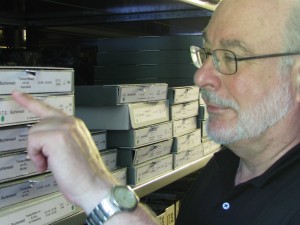 Prof. Waltzer has written and shown pictures of himself (right) doing research at Bad Arolson in Germany, seeking to discover details about the lives and families of the boys of Buchenwald. One of the boys that he may be having trouble with is Elie Wiesel. Waltzer has made a lot of claims and put himself on the line about Wiesel that, in this writer’s opinion, cannot be substantiated.
Prof. Waltzer has written and shown pictures of himself (right) doing research at Bad Arolson in Germany, seeking to discover details about the lives and families of the boys of Buchenwald. One of the boys that he may be having trouble with is Elie Wiesel. Waltzer has made a lot of claims and put himself on the line about Wiesel that, in this writer’s opinion, cannot be substantiated.
For example, last November Waltzer commented on this website to my article “Signatures Prove Lázár Wiesel is not Elie Wiesel” with the following:
Contrary to Carolyn Yeager’s wishful thinking, Eli Wiesel was indeed the Lazar Wiesel who was admitted to Buchenwald on January 26, 1945, who was subsequently shifted to block 66, and who was interviewed by military authorities before being permitted to leave Buchenwald to go with other Buchenwald orphans to France. Furthermore, there is not a shadow of a doubt about this, although the Buchenwald records do erroneously contain — on some pieces — the birth date of 1913 rather than 1928. A forthcoming paper resolves the “riddle of Lazar” and indicates that Miklos Gruner’s Stolen Identity is a set of false charges and attack on Wiesel without any foundation. ~~ by kenwaltzer on November 14, 2010 at 10:34 am
The birthdate on Lazar Wiesel’s records is erroneous—that’s his answer? He is going to “resolve” that? The “forthcoming paper” has not yet appeared 7 months later. His website pages have not been updated for awhile; in fact, they look downright dormant.
Here are the problems I think Waltzer is having, in addition to the birthdate problem:
- He has claimed for at least several years that a picture he has placed on his website of the boys walking out of the Buchenwald front gate shows Elie Wiesel “toward the left.” [See The Many Faces of Elie Wiesel] I say it is not Elie Wiesel, and I don’t know anyone but Waltzer who has identified this boy as Elie Wiesel. This picture is also shown on the USHMM website, and they make no mention of Elie Wiesel as one of the boys.
- In a Power Point presentation that is available on his website, Waltzer shows a group picture of the ‘religious boys’ out of those who went to France, that he says includes Elie Wiesel. I have studied this picture closely and do not see anyone who resembles Wiesel. If Waltzer knows that Elie Wiesel is in the picture, why doesn’t he identify him with an arrow?
Famous Buchenwald Liberation photo is another problem
As I pointed out in “The Many Faces of Elie Wiesel,” the pictures that Waltzer claims contain the face and person of Elie Wiesel do not resemble each other. The famous barracks photo which the New York Times declared to be Elie Wiesel as a 16-year old Buchenwald inmate—and is reproduced all over the world as Elie Wiesel—doesn’t look like the other 16-year old faces.
This writer suspects that Ken Waltzer is having difficulty convincingly incorporating Elie Wiesel into the story of the “boys of Buchenwald” and their rescue. He has been a friend and devotee of Wiesel for many years, they are both strongly associated with the U.S. Holocaust Memorial Museum, and Wiesel has been a part of his Buchenwald story from the beginning. But the real evidence for Elie Wiesel ever being an inmate at Buchenwald doesn’t exist. There are no photographs of Elie Wiesel at Buchenwald; there are no photos of Wiesel during his supposed one-year concentration camp period at all.
I think Waltzer believed this slipshod approach he employs would pass without comment, but he didn’t count on the appearance of Elie Wiesel Cons the World website. We are a real problem for Ken Waltzer!
10 Comments
Category Featured | Tags: Tags: Bad Arolson, Boys from Buchenwald, Elie Wiesel, Kenneth Waltzer, Michigan State University, New York Times, USHMM,
Social Networks: Facebook, Twitter, Google Bookmarks, del.icio.us, StumbleUpon, Digg, Reddit, Posterous.







